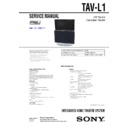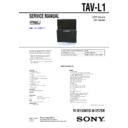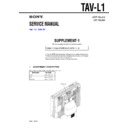Sony TAV-L1 (serv.man3) Service Manual ▷ View online
SERVICE MANUAL
INTEGRATED HOME THEATRE SYSTEM
US Model
Canadian Model
TAV-L1
Ver. 1.2 2009.11
SPECIFICATIONS
9-887-306-03
2009K05-1
© 2009.11
© 2009.11
Sony Corporation
Audio&Video Business Group
Published by Sony Techno Create Corporation
Published by Sony Techno Create Corporation
– Continued on next page –
Model Name Using Similar Mechanism
NEW
DVD Mechanism Type
CDM86-DVBU101
Optical Pick-up Block Name
KHM-310CAB or KHM-313CAB
AUDIO POWER SPECIFICATIONS
for the US model
for the US model
POWER OUTPUT AND
TOTAL HARMONIC
DISTORTION:
TOTAL HARMONIC
DISTORTION:
With 6 ohm loads, both channels driven, from 200 - 20,000
Hz; rated 40 watts per channel minimum RMS power, with
no more than 0.7% total harmonic distortion from 250 milli
watts to rated output.
Hz; rated 40 watts per channel minimum RMS power, with
no more than 0.7% total harmonic distortion from 250 milli
watts to rated output.
Display unit
Power Requirements:
120 V AC, 60 Hz
Screen Size:
32 inches
Approx. 101.5 cm measured diagonally
Approx. 101.5 cm measured diagonally
Display Resolution:
1,366 dots (horizontal)
× 768 lines (vertical)
Power Consumption:
210 W
Standby Power Consumption:
1 W or less
Dimensions (w
× h × d):
Approx. 856.0
× 1,069.0 × 470.0 mm (3 × 3
3
/
4
× 42
1
/
8
×
18
5
/
8
in)
Mass:
Approx. 58.0 kg (127 lb 14 oz)
Panel system
LCD (Liquid Crystal Display) Panel
Terminals
• VIDEO IN 1/2/3 (NTSC Video Standard):
S VIDEO (4-pin mini DIN):
Y:1.0 Vp-p, 75 ohms unbalanced,
sync negative
C: 0.286 Vp-p (Burst signal), 75 ohms
VIDEO:
1 Vp-p, 75 ohms unbalanced, sync
negative
negative
AUDIO:
500 mVrms (100% modulation)
Impedance: 47 kilohms
Impedance: 47 kilohms
• VIDEO 5 (HDMI IN):
HDMI:
Video: 480i, 480p, 720p, 1080i
Audio IN: Two channel linear PCM
32, 44.1 and 48 kHz, 16, 20 and 24 bits
Audio IN: Two channel linear PCM
32, 44.1 and 48 kHz, 16, 20 and 24 bits
AUDIO IN:
500 mVrms (100% modulation)
Impedance: 47 kilohms
Impedance: 47 kilohms
• Digital audio inputs (coaxial):
VIDEO 1-3, 5, 6
Impedance: 75 ohms
Impedance: 75 ohms
• VIDEO 6 (PC IN):
D-sub 15-pin, analog RGB, 0.7 Vp-p, 75 ohms, positive
• PC AUDIO IN:
Stereo mini jack, 500m Vrms, 1 kilohm
• i Headphones jack
This system incorporates with Dolby*
1
Digital and
Dolby Pro Logic (II) adaptive matrix surround
decoder and the DTS*
decoder and the DTS*
2
Digital Surround System.
*1 Manufactured under license from Dolby Laboratories.
“Dolby,” “Pro Logic,” and the double-D symbol are
trademarks of Dolby Laboratories.
trademarks of Dolby Laboratories.
*2 Manufactured under license from Digital Theater Systems,
Inc.
“DTS” and “DTS Digital Surround” are registered trademarks
of Digital Theater Systems, Inc.
“DTS” and “DTS Digital Surround” are registered trademarks
of Digital Theater Systems, Inc.
2
TAV-L1
SAFETY-RELATED COMPONENT WARNING!!
COMPONENTS IDENTIFIED BY MARK
0
OR DOTTED LINE
WITH MARK
0
ON THE SCHEMATIC DIAGRAMS AND IN
THE PARTS LIST ARE CRITICAL TO SAFE OPERATION.
REPLACE THESE COMPONENTS WITH SONY PARTS WHOSE
PART NUMBERS APPEAR AS SHOWN IN THIS MANUAL OR
IN SUPPLEMENTS PUBLISHED BY SONY.
REPLACE THESE COMPONENTS WITH SONY PARTS WHOSE
PART NUMBERS APPEAR AS SHOWN IN THIS MANUAL OR
IN SUPPLEMENTS PUBLISHED BY SONY.
Notes on chip component replacement
• Never reuse a disconnected chip component.
• Notice that the minus side of a tantalum capacitor may be
damaged by heat.
Flexible Circuit Board Repairing
• Keep the temperature of the soldering iron around 270 ˚C
during repairing.
• Do not touch the soldering iron on the same conductor of the
circuit board (within 3 times).
• Be careful not to apply force on the conductor when soldering
or unsoldering.
CAUTION
Use of controls or adjustments or performance of procedures
other than those specified herein may result in hazardous radiation
exposure.
other than those specified herein may result in hazardous radiation
exposure.
Amplifier section
Front
Power output (rated): 40 W + 40 W
(6 ohms, 1 kHz, THD 1 %)
Continuous RMS power output
(reference): 50 W + 50 W
(6 ohms at 1 kHz, THD 10 %)
(6 ohms, 1 kHz, THD 1 %)
Continuous RMS power output
(reference): 50 W + 50 W
(6 ohms at 1 kHz, THD 10 %)
Subwoofer
Power output (rated): 80 W
(3 ohms, 100 Hz, THD 1 %)
Continuous RMS power output
(reference): 100 W
(3 ohms at 100 Hz, THD 10 %)
(3 ohms, 100 Hz, THD 1 %)
Continuous RMS power output
(reference): 100 W
(3 ohms at 100 Hz, THD 10 %)
Super Audio CD/DVD system
Laser
Semiconductor laser
(DVD:
(DVD:
λ = 650 nm)
(CD:
λ = 790 nm)
Emission duration: continuous
FM section
System
PLL quartz-locked digital
synthesizer system
synthesizer system
Tuning range
87.5 – 108.0 MHz
Antenna
FM wire antenna
Antenna terminals
75 ohms, unbalanced
Intermediate frequency
10.7 MHz
Speakers
Front
Speaker system
2-way Bass reflex type
Speaker unit
25 mm (1 in) Dome type,
80 mm (3
80 mm (3
1
/
4
in) Cone type
Subwoofer
Speaker system
Bass reflex type
Speaker unit
130 mm (5
1
/
8
in) Cone type
× 2
Supplied accessories
• Remote RM-ANP003 (1)
• Size AA batteries (R6 type) (2)
• AC power cord (mains lead) (1)
• HD 15-HD 15 cable (1)
• Screws (2)
• FM wire antenna (1)
• Frame grille (1)
• Quick Setup Guide (1)
• Size AA batteries (R6 type) (2)
• AC power cord (mains lead) (1)
• HD 15-HD 15 cable (1)
• Screws (2)
• FM wire antenna (1)
• Frame grille (1)
• Quick Setup Guide (1)
Design and specifications are subject to change
without notice.
without notice.
SAFETY CHECK-OUT
After correcting the original service problem, perform the following
safety check before releasing the set to the customer:
Check the antenna terminals, metal trim, “metallized” knobs, screws,
and all other exposed metal parts for AC leakage.
Check leakage as described below.
safety check before releasing the set to the customer:
Check the antenna terminals, metal trim, “metallized” knobs, screws,
and all other exposed metal parts for AC leakage.
Check leakage as described below.
LEAKAGE TEST
The AC leakage from any exposed metal part to earth ground and
from all exposed metal parts to any exposed metal part having a
return to chassis, must not exceed 0.5 mA (500 microamperes.).
Leakage current can be measured by any one of three methods.
from all exposed metal parts to any exposed metal part having a
return to chassis, must not exceed 0.5 mA (500 microamperes.).
Leakage current can be measured by any one of three methods.
1. A commercial leakage tester, such as the Simpson 229 or RCA
WT-540A. Follow the manufacturers’ instructions to use these
instruments.
instruments.
2. A battery-operated AC milliammeter. The Data Precision 245
digital multimeter is suitable for this job.
3. Measuring the voltage drop across a resistor by means of a
VOM or battery-operated AC voltmeter. The “limit” indication
is 0.75 V, so analog meters must have an accurate low-voltage
scale. The Simpson 250 and Sanwa SH-63Trd are examples
of a passive VOM that is suitable. Nearly all battery operated
digital multimeters that have a 2 V AC range are suitable. (See
Fig. A)
is 0.75 V, so analog meters must have an accurate low-voltage
scale. The Simpson 250 and Sanwa SH-63Trd are examples
of a passive VOM that is suitable. Nearly all battery operated
digital multimeters that have a 2 V AC range are suitable. (See
Fig. A)
Fig. A.
Using an AC voltmeter to check AC leakage.
1.5 k
Ω
0.15
µ
F
AC
voltmeter
(0.75 V)
voltmeter
(0.75 V)
To Exposed Metal
Parts on Set
Parts on Set
Earth Ground
ATTENTION AU COMPOSANT AYANT RAPPORT
À LA SÉCURITÉ!
LES COMPOSANTS IDENTIFIÉS PAR UNE MARQUE
0
SUR
LES DIAGRAMMES SCHÉMATIQUES ET LA LISTE DES
PIÈCES SONT CRITIQUES POUR LA SÉCURITÉ DE
FONCTIONNEMENT. NE REMPLACER CES COM- POSANTS
QUE PAR DES PIÈCES SONY DONT LES NUMÉROS SONT
DONNÉS DANS CE MANUEL OU DANS LES SUPPLÉMENTS
PUBLIÉS PAR SONY.
PIÈCES SONT CRITIQUES POUR LA SÉCURITÉ DE
FONCTIONNEMENT. NE REMPLACER CES COM- POSANTS
QUE PAR DES PIÈCES SONY DONT LES NUMÉROS SONT
DONNÉS DANS CE MANUEL OU DANS LES SUPPLÉMENTS
PUBLIÉS PAR SONY.
3
TAV-L1
(When letters/numbers appear in the display)
When the self-diagnosis function is activated to prevent the system from malfunctioning, a 5-character service
number (e.g., C 13 50) with a combination of a letter and 4 digits appears on the screen and the front panel display.
In this case, check the following table.
number (e.g., C 13 50) with a combination of a letter and 4 digits appears on the screen and the front panel display.
In this case, check the following table.
When displaying the version number on the screen
When you turn on the system, the version number [VER.X.XX] (X is a number) may appear on the screen. Although this
is not a malfunction and for Sony service use only, normal system operation will not be possible. Turn off the system, and
then turn on the system again to operate.
is not a malfunction and for Sony service use only, normal system operation will not be possible. Turn off the system, and
then turn on the system again to operate.
Self-diagnosis function (DVD function only)
First 3 characters of the service
number
number
Cause and/or corrective action
C 13
The disc is dirty.
Clean the disc with a soft cloth.
Clean the disc with a soft cloth.
C 31
The disc is not inserted correctly.
Restart the system, then re-insert the disc correctly.
Restart the system, then re-insert the disc correctly.
E XX
(xx is a number)
(xx is a number)
To prevent a malfunction, the system has performed the self-diagnosis
function.
Contact your nearest Sony dealer or local authorized Sony service facility
and give the 5-character service number.
Example: E 61 10
function.
Contact your nearest Sony dealer or local authorized Sony service facility
and give the 5-character service number.
Example: E 61 10
C:13:50
VER.X.XX
SELF DIAGNOSIS FUNCTION
DESCRIPTION OF LED INDICATORS
LED
LED Type
Description
Light is green when the TV set is on
POWER LED Red/Green LED Function as failure indicator
Blinks green in aging mode
SLEEP LED
Red LED
Lights when timer is set
PIC OFF LED
Green LED
Lights when power saving setting is
set to picture off
DIAGNOSTIC TEST INDICATORS
When an error occurs, the [POWER] LED will flash a set number of
times to indicate the possible cause of the problem. If there is more
than one error, the LED will identify the first of the problem areas.
If the errors occur simultaneously, the one that corresponds to the
fewest flashes is identified first. Results for all of the following
diagnostic items are displayed on screen. No error has occurred if
the screen display a “0”.
times to indicate the possible cause of the problem. If there is more
than one error, the LED will identify the first of the problem areas.
If the errors occur simultaneously, the one that corresponds to the
fewest flashes is identified first. Results for all of the following
diagnostic items are displayed on screen. No error has occurred if
the screen display a “0”.
Number of Times
Monitoring Item
POWER LED Blinks
1 Time
Abnormal AU Power Voltage (DCALERT 3)
2 Times
Abnormal D5V/A9V Power Voltage
(DCALERT 2)
3 Times
Abnormal Panel Voltage (DCALERT 1)
4 Times
Backlight Failure
5 Times
Abnormal Main Power Voltage
6 Times
Abnormal Speaker Voltage
7 Times
Internal Temperature Rise
(Mainly on the Panel Side)
LED CONTROL
Status
POWER LED
SLEEP LED
PIC OFF LED
Remarks
Power off using the [POWER] button or remote commander.
Power Off
Off
Off
Off
Note:
Standby state does not exist in WAX; however, the
microcomputer does enter into sleep mode.
Power Off
Lights Green
Off
Off
Microcomputer working normally.
Failure
Blinks Red
Off
Off
Failure causes are classified by the number of time the red light blinks.
Aging
Blinks Green
Off
Off
Aging mode is classified by a blinking green light.
Picture Off
Lights Green
Off
Lights Green
No display (black screen).
SLEEP TIMER
Lights Green
Lights Red
Off
When SLEEP TIMER is set during power on.
Lights Green
Lights Red
Lights Green
When SLEEP TIMER is set in Picture Off mode.
Off
Lights Red
Off
When ON TIMER is set and power is off.
ON TIMER
Lights Green
Lights Red
Off
When ON TIMER is set and power is on.
Lights Green
Lights Red
Lights Green
When ON TIMER is set in Picture Off mode.
The units in this manual contain a self-diagnostic function. If an error occurs, the [POWER] LED will automatically begin to flash. The
number of times the LED flashes translates to a probable source of the problem. A definition of the [POWER] LED flash indicators is listed
in the instruction manual for the user’s knowledge and reference. If an error symptom is difficult to reproduced use the remote commander
to display the record that is stored at the internal NVM to specify the cause of the failure.
number of times the LED flashes translates to a probable source of the problem. A definition of the [POWER] LED flash indicators is listed
in the instruction manual for the user’s knowledge and reference. If an error symptom is difficult to reproduced use the remote commander
to display the record that is stored at the internal NVM to specify the cause of the failure.
4
TAV-L1
TABLE OF CONTENTS
1.
SERVICING NOTES
...............................................
6
2.
GENERAL
................................................................... 17
3.
DISASSEMBLY
3-1.
Disassembly Flow ........................................................... 19
3-2.
DVD Block ...................................................................... 20
3-3.
Driving Block .................................................................. 21
3-4.
TV Support Cover ........................................................... 22
3-5.
Rear Cabinet .................................................................... 23
3-6.
LCD Block ...................................................................... 24
3-7.
Front Cabinet Assy .......................................................... 25
3-8.
LCD Panel Unit ............................................................... 26
3-9.
Subwoofer Block ............................................................. 27
3-10. Center Cover Assy ........................................................... 28
3-11. DVD Mechanism Deck (CDM86-DVBU101) ................ 29
3-12. Optical Pick-Up Block
3-11. DVD Mechanism Deck (CDM86-DVBU101) ................ 29
3-12. Optical Pick-Up Block
(KHM-310CAB or KHM-313CAB) ............................... 30
3-13. Motor (Pulley) Assy (Loading) (M001) .......................... 30
3-14. Holder (BU) Assy ............................................................ 31
3-15. Lever (BU Lock) ............................................................. 31
3-16. Close Lever ...................................................................... 32
3-17. Lever (DIR), Gear (IDL-B) ............................................. 32
3-18. Chassis (Top) ................................................................... 33
3-19. Lever (Loading-L/R) ....................................................... 34
3-20. Lever (Disc Senser)/(Disc Stop) ...................................... 35
3-21. Gear (IDL-C) ................................................................... 35
3-14. Holder (BU) Assy ............................................................ 31
3-15. Lever (BU Lock) ............................................................. 31
3-16. Close Lever ...................................................................... 32
3-17. Lever (DIR), Gear (IDL-B) ............................................. 32
3-18. Chassis (Top) ................................................................... 33
3-19. Lever (Loading-L/R) ....................................................... 34
3-20. Lever (Disc Senser)/(Disc Stop) ...................................... 35
3-21. Gear (IDL-C) ................................................................... 35
4.
TEST MODE
.............................................................. 36
5.
MECHANICAL ADJUSTMENTS
....................... 42
6.
ELECTRICAL ADJUSTMENTS
......................... 44
7.
DIAGRAMS
7-1.
Frame Printed Wiring Boards – MAIN Section – .......... 47
7-2.
Frame Printed Wiring Boards
– MONITOR Section – .................................................. 48
– MONITOR Section – .................................................. 48
7-3.
Frame Printed Wiring Boards
– POWER SUPPLY Section – ........................................ 49
– POWER SUPPLY Section – ........................................ 49
7-4.
Block Diagram – DVD SERVO Section – ..................... 50
7-5.
Block Diagram – TV AUDIO Section – ......................... 51
7-6.
Block Diagram – TV MONITOR Section – ................... 52
7-7.
Block Diagram – AUDIO DSP Section – ....................... 53
7-8.
Block Diagram – AUDIO AMP Section – ...................... 54
7-9.
Block Diagram
– PANEL/LIFT CONTROL Section – ........................... 55
– PANEL/LIFT CONTROL Section – ........................... 55
7-10. Block Diagram – TV POWER SUPPLY Section – ........ 56
7-11. Block Diagram
7-11. Block Diagram
– AUDIO POWER SUPPLY Section – .......................... 57
7-12. Schematic Diagram – SERVO Section (1/3) – ............... 59
7-13. Schematic Diagram – SERVO Section (2/3) – ............... 60
7-14. Schematic Diagram – SERVO Section (3/3) – ............... 61
7-15. Printed Wiring Boards – SERVO Section (1/2) – ........... 62
7-16. Printed Wiring Board – SERVO Section (2/2) – ............ 63
7-17. Printed Wiring Board – VIDEO-UC Board – ................. 64
7-18. Schematic Diagram – VIDEO-UC Board – ................... 65
7-19. Printed Wiring Board
7-13. Schematic Diagram – SERVO Section (2/3) – ............... 60
7-14. Schematic Diagram – SERVO Section (3/3) – ............... 61
7-15. Printed Wiring Boards – SERVO Section (1/2) – ........... 62
7-16. Printed Wiring Board – SERVO Section (2/2) – ............ 63
7-17. Printed Wiring Board – VIDEO-UC Board – ................. 64
7-18. Schematic Diagram – VIDEO-UC Board – ................... 65
7-19. Printed Wiring Board
– MAIN Board (Component Side) – .............................. 66
7-20. Printed Wiring Board
– MAIN Board (Conductor Side) – ................................ 67
7-21. Schematic Diagram – MAIN Board (1/6) – ................... 68
7-22. Schematic Diagram – MAIN Board (2/6) – ................... 69
7-23. Schematic Diagram – MAIN Board (3/6) – ................... 70
7-24. Schematic Diagram – MAIN Board (4/6) – ................... 71
7-25. Schematic Diagram – MAIN Board (5/6) – ................... 72
7-26. Schematic Diagram – MAIN Board (6/6) – ................... 73
7-27. Printed Wiring Board – CONNECT-UC Board – .......... 74
7-28. Schematic Diagram – CONNECT-UC Board – ............. 75
7-29. Printed Wiring Boards
7-22. Schematic Diagram – MAIN Board (2/6) – ................... 69
7-23. Schematic Diagram – MAIN Board (3/6) – ................... 70
7-24. Schematic Diagram – MAIN Board (4/6) – ................... 71
7-25. Schematic Diagram – MAIN Board (5/6) – ................... 72
7-26. Schematic Diagram – MAIN Board (6/6) – ................... 73
7-27. Printed Wiring Board – CONNECT-UC Board – .......... 74
7-28. Schematic Diagram – CONNECT-UC Board – ............. 75
7-29. Printed Wiring Boards
– SENSOR/SWITCH Section – ..................................... 76
7-30. Schematic Diagram – SENSOR/SWITCH Section – ..... 77
7-31. Printed Wiring Board
7-31. Printed Wiring Board
– SUB Board (Component Side) – ................................. 78
7-32. Printed Wiring Board
– SUB Board (Conductor Side) – ................................... 79
7-33. Schematic Diagram – SUB Board (1/3) – ...................... 80
7-34. Schematic Diagram – SUB Board (2/3) – ...................... 81
7-35. Schematic Diagram – SUB Board (3/3) – ...................... 82
7-36. Printed Wiring Board – LINK UC Board – .................... 82
7-37. Schematic Diagram – LINK UC Board – ...................... 83
7-38. Printed Wiring Boards – AUX IN/OUT Section – ......... 84
7-39. Schematic Diagram – AUX IN/OUT Section – .............. 85
7-40. Printed Wiring Board
7-34. Schematic Diagram – SUB Board (2/3) – ...................... 81
7-35. Schematic Diagram – SUB Board (3/3) – ...................... 82
7-36. Printed Wiring Board – LINK UC Board – .................... 82
7-37. Schematic Diagram – LINK UC Board – ...................... 83
7-38. Printed Wiring Boards – AUX IN/OUT Section – ......... 84
7-39. Schematic Diagram – AUX IN/OUT Section – .............. 85
7-40. Printed Wiring Board
– A3-AU Board (Component Side) – ............................. 86
7-41. Printed Wiring Board
– A3-AU Board (Conductor Side) – ............................... 87
7-42. Schematic Diagram – A3-AU Board (1/4) – .................. 88
7-43. Schematic Diagram – A3-AU Board (2/4) – .................. 89
7-44. Schematic Diagram – A3-AU Board (3/4) – .................. 90
7-45. Schematic Diagram – A3-AU Board (4/4) – .................. 91
7-46. Printed Wiring Board – B Board – ................................. 92
7-47. Schematic Diagram – B Board (1/5) – ........................... 93
7-48. Schematic Diagram – B Board (2/5) – ........................... 94
7-49. Schematic Diagram – B Board (3/5) – ........................... 95
7-50. Schematic Diagram – B Board (4/5) – ........................... 96
7-51. Schematic Diagram – B Board (5/5) – ........................... 97
7-52. Printed Wiring Board – PANEL-UC Board – ................ 98
7-53. Schematic Diagram – PANEL-UC Board – ................... 99
7-54. Printed Wiring Boards – KEY Section – ........................ 100
7-55. Schematic Diagram – KEY Section – ............................ 101
7-56. Printed Wiring Board
7-43. Schematic Diagram – A3-AU Board (2/4) – .................. 89
7-44. Schematic Diagram – A3-AU Board (3/4) – .................. 90
7-45. Schematic Diagram – A3-AU Board (4/4) – .................. 91
7-46. Printed Wiring Board – B Board – ................................. 92
7-47. Schematic Diagram – B Board (1/5) – ........................... 93
7-48. Schematic Diagram – B Board (2/5) – ........................... 94
7-49. Schematic Diagram – B Board (3/5) – ........................... 95
7-50. Schematic Diagram – B Board (4/5) – ........................... 96
7-51. Schematic Diagram – B Board (5/5) – ........................... 97
7-52. Printed Wiring Board – PANEL-UC Board – ................ 98
7-53. Schematic Diagram – PANEL-UC Board – ................... 99
7-54. Printed Wiring Boards – KEY Section – ........................ 100
7-55. Schematic Diagram – KEY Section – ............................ 101
7-56. Printed Wiring Board
– G2 SOEM Board (Component Side) – ........................ 102
7-57. Printed Wiring Board
– G2 SOEM Board (Conductor Side) – .......................... 103
7-58. Schematic Diagram – G2 SOEM Board – ...................... 104
7-59. Schematic Diagram – POWER Board – ......................... 105
7-60. Printed Wiring Board
7-59. Schematic Diagram – POWER Board – ......................... 105
7-60. Printed Wiring Board
– POWER Board (Component Side) – ........................... 106
7-61. Printed Wiring Board
– POWER Board (Conductor Side) – ............................. 107





